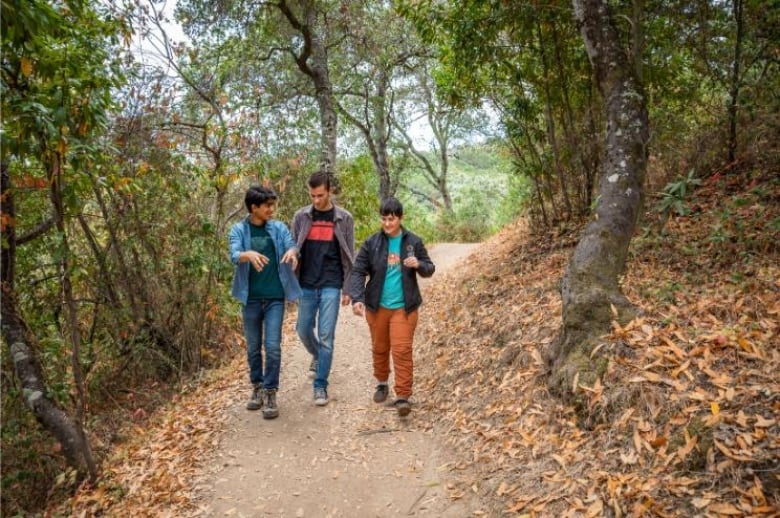California teens discover 2 new scorpion species — and they’re just getting started | CBC Radio
As It Happens6:49California teens discover 2 new scorpion species — and they’re just getting started
When Prakrit Jain and Harper Forbes first saw the picture of an unidentified scorpion in the California desert, they knew they were looking at something special.
The teenage duo know a lot about scorpions. Both budding young scientists are passionate about ecology, and are on a mission to document every species of the arachnid in California.
They were looking through photos on the citizen-science website iNaturalist when they saw an image that caught their attention — a translucent, brownish scorpion that didn’t look like any species they were familiar with.
“We immediately knew that they were something new,” Jain told As It Happens host Nil Köksal.
After some meticulous field work, the pair confirmed it was, indeed, a previously undescribed species. They dubbed it Paruroctonus soda, because it lives in the salty clay soil near Soda Lake in San Luis Obispo County. It’s one of two new species of scorpion they have described in a new paper published this month in the journal ZooKeys.
Following a childhood passion
Jain, 18, and Forbes, 19, published their findings in collaboration with Lauren Esposito, a California Academy of Sciences arachnologist who has been a mentor to them both.
Esposito says they first met Jain at a local science event when he was about 11 years old. Already, he was brimming with knowledge about the California landscape.
“He was just, like, extremely enthused about literally everything,” Esposito said.
Jain says his fascination with nature began when he was a child going on hikes with his family. His parents, he said, did a great job of encouraging his curiosity and helping him learn how to interact safely with wildlife without being afraid.
“I recall the first scorpion I saw was when I was like eight or 10 years old, and I found that really, really cool,” Jain said.
“I think I know more than most people about California scorpions, but far, far from everything that there is to know. Almost every week, I learn something new about California scorpions that I didn’t know before.”
Newly identified, and already in danger
And there’s a lot to learn. California is one of the most diverse regions in the world for scorpions, says Esposito.
“There’s, like, more scorpion species in California than there are in pretty much the rest of the United States combined. But there’s no resources … to identify them,” they said.
So Esposito, Jain and Harper set out to create those resources themselves. Esposito says the young men traveled the state with their families, photographing and detailing the scorpions they came across.
When they saw P. soda online last year, they traveled to Soda Lake to look for more specimens to confirm their suspicion it was a new species.
Looking for scorpions means trekking the California dessert on moonless nights with an ultraviolet light under which most scorpions look bright blue and green.
“It is really a beautiful and calm experience,” Jain said. “The desert is so vast and empty and gorgeous, especially at night. It’s really a special experience.”
A few months later, they traveled to the Mojave Desert in Kern County, where they found another previously unrecorded species. They dubbed this one Paruroctonus conclusus.
Conclusus is Latin for “confined or limited.” Jain says the scorpion only exists in a small habitat around Koehn Lake, “which is something that makes it especially vulnerable to extinction if there’s any sort of external threat to its habitat, whether that be urban development or energy projects or mining or anything like that.”
They’re not quite as scary as people make them out to be.– Prakrit Jain, UC Berkeley student
In fact, both species appear to be restricted to their environments in Soda Lake and Koehn Lake. Both are alkali flats, or salt lakes, which are the remnants of glacial lakes from some 10,000 yeas ago.
“The glaciers completely melted or receded back, and what was left behind was a lake that dried out over time because it no longer had access to a source of freshwater, and so they became … super salty. And the plants and animals that were living around them as they either adapt to that hyper-salinity or they went extinct,” Esposito said.
“And so that’s exactly the case of what’s happened with these scorpions. I suspect that they were probably a part of a thriving ecosystem that lived around … these two isolated lakes. And over time, as those lakes dried up, they adapted to that changing environment and became capable of dealing with this sort of hyper-saline system and are just sort of clinging to life on the plants that also did the same.”

P. soda lives within the Carrizo national monument, which means it’s a protected species. P. conclusus is not so fortune.
Jain and Harper are now working with the International Union for Conservation of Nature to study P. conclusus further and determine whether the species should be classified as threatened so it can be protected under federal law.
“Scorpion conservation is really important not only for these endangered scorpions, but for the really endangered ecosystems they’re living in,” Jain said.
Since their discovery, life has separated the young scorpion-finders. Jain is now a first-year student at the University of California, Berkeley, while Forbes, who CBC was unable to reach for comment, is at the University of Arizona.
But Esposito says the scorpion identification project continues, and there are likely many new species out there, just waiting to be found.
“They’re not quite as scary as people make them out to be,” Jain said. “And they’re a lot more valuable to desert ecosystems than I think a lot of people realize.”
Interview with Prakrit Jain produced by Katie Geleff.
For all the latest Technology News Click Here
For the latest news and updates, follow us on Google News.

